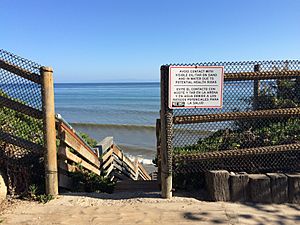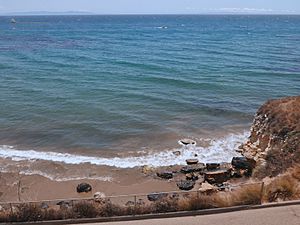Refugio oil spill facts for kids
Quick facts for kids Refugio oil spill |
|
|---|---|

Crude oil washes up on Refugio State Beach
|
|
| Location | Gaviota Coast, north of Santa Barbara, California |
| Coordinates | 34°27′45″N 120°05′11″W / 34.46250°N 120.08639°W |
| Date | May 19, 2015 |
| Cause | |
| Cause | Ruptured pipeline |
| Operator | Plains All American Pipeline |
| Spill characteristics | |
| Volume | 105,000 U.S. gallons (2,500 barrels) |
| Shoreline impacted | 7 miles (11 km) coated with crude oil; tar balls damaged beaches more than 100 miles (160 km) down the coast |
The Refugio oil spill on May 19, 2015, deposited 142,800 U.S. gallons (3,400 barrels; 541,000 liters) of crude oil onto one of the most biologically diverse areas of the West Coast of the United States. The corroded pipeline blamed for the spill closed indefinitely, resulting in financial impacts to the county estimated as high as $74 million as it and a related pipeline remained out of service for three years. The cost of the cleanup was estimated by the company to be $96 million with overall expenses including expected legal claims and potential settlements to be around $257 million.
The oil spill, on the Gaviota Coast immediately north of Refugio State Beach in Santa Barbara County, California, originated in a 2 feet (61 cm) diameter underground pipeline named Line 901 owned by Plains All American Pipeline. Crude oil produced by offshore platforms was transported from onshore receiving plants to another pipeline that transported the oil inland for processing. The oil pipeline operators in Midland, Texas had turned off an alarm that would have notified them of the leak as they were dealing with a separate problem with a pump. The 28-year-old pipeline was not equipped with an automatic shut-off valve and was eventually shut down by control operators when they were notified of the leak from parties who visually located the spill.
Hundreds of animals along the coast were coated with the thick crude oil and many died. State parks and beaches located along the Gaviota Coast were temporarily closed. While much smaller than the oil rig blowout that resulted in the 1969 Santa Barbara oil spill, this spill may have greater long term effects due to its potential impact on four state marine protected areas. Due to the unique characteristics of the area, it is one of the most studied marine environments in the United States.
Aftermath
Environmental effect
The spill was much smaller than the nearby 1969 Santa Barbara oil spill on January 28, 1969 in which an oil rig blow-out spilled an estimated 3.4 to 4.2 million US gallons (81,000 to 100,000 bbl; 13,000 to 16,000 m3) of crude oil over a ten-day period.
The thick crude oil damaged the coats, skin, beaks, and appendages of hundreds of animals. Workers eventually collected 202 dead birds and 99 dead mammals which included at least 46 sea lions and 12 dolphins. The full impact will never be known since animals may travel a distance before succumbing to their injuries. Sixty-five live birds and sixty-three live mammals were rescued.
Of the 69 animals freed after being cleaned and nursed back to health, 10 were adult Brown pelicans that were released at Goleta Beach after spending three weeks in San Pedro with a team of scientists from the Oiled Wildlife Care Network that is administered by the UC Davis School of Veterinary Medicine. In September 2015, SeaWorld San Diego released the last three sea lions affected by the oil spill at Border Field State Park. Scientists will monitor the movements of some of the sea lions and at least five of the pelicans with satellite transmitters.
The spill cleanup occurred during the nesting season for snowy plovers so special precautions were necessary while cleaning up tar balls. The birds are often found on the beaches along the coast of the Oxnard plain. Their nests are hard to see in the open sand and the birds are easily frightened away by human activity leaving the eggs to fast-moving predators such as sea gulls. Least terns were another endangered species of bird that was a concern during the cleanup efforts.
Marine researchers note that mammals and birds get the most attention but smaller creatures at the base of the ocean food chain are also harmed by the oil. Life on the sea floor and near the shore such as mussels, barnacles, and other shellfish are unable to move out of the way. When exposed to oil, these organisms suffer 90%-plus mortality and recovery of the population can take decades.

Researchers from the University of California, Santa Barbara began collecting samples within hours of the spill to monitor the impact on the marine environment. Researchers and volunteers returned to the area many times to collect additional samples. Since students and researchers had previously used this area for study purposes, baseline data was available. David Valentine, a professor in the university's Department of Earth Science said, “The discharge of heavy oil at Refugio presents a unique opportunity to discover novel metabolic, genomic and ecological feedbacks among marine microbial communities, heavy oil and ecosystem response. We have the opportunity to study ecosystem changes and microbial reactions from the very early stages through an entire year. It’s really rare for scientists to get day zero access to any sort of event like this.”
Economic impact
Plains All American Pipeline estimated that the cleanup had cost $96 million during a joint oversight hearing of the State Assembly Natural Resources Committee and Senate Select Committee on June 26, 2015. Overall expenses related to the spill were estimated to be $257 million in an earnings report for Plains All American Pipeline issued around the same time. This included the emergency response and cleanup efforts along with the expected legal claims and potential settlements. The CEO stated in the report that all but $65 million would be covered by insurance and that the figure did not include lost revenue from the pipelines that have been shut down. The Oil Pollution Act of 1990 requires whoever spills the oil to pay for the cleanup.
The economic consequences for the county were more difficult to quantify. The financial impact on the county was estimated by the California Economic Forecast Director at $74 million if Line 901 remains dormant for three years because of the dependence of the region's oil and gas industry to move product through this line. Workers' income, property taxes, and federal royalties are reduced while the line is out of service. The impact on tourism was not as bad as predicted and thousands of workers involved in the cleanup appear to have benefited some hotels.
In response to the spill, 138 square miles (360 km2) of fisheries were closed. The order was lifted after six weeks when the Office of Environmental Health Hazard Assessment determined that the area's seafood was safe to eat and posed “no significant health threat.” The closure impacted commercial fishermen and fishing charters. Local commercial fishermen reported that it was tough to sell the fish caught outside of the closed area because of the impression that all of the region's seafood was tainted from the oil spill. There is also a long term concern that the oil may have wiped out the main food source for some sea life in the area. The predominant products from the Santa Barbara region are red sea urchin and red rock crab with an average of $11 million in sales revenue per year
Recreation impacts
Although lightly populated, recreation brings outdoor enthusiasts to the Gaviota Coast. The spill affected visitors to both public and private facilities in the area. The state closed heavily used El Capitán State Beach for a month, which was finally reopened on June 26 for camping and day use. Refugio State Beach was more heavily damaged and did not reopen until July 17, 2015. These two popular parks quickly filled up with summer crowds when they reopened. Eric Hjelstrom, California State Parks sector superintendent said, “We were booked full the day we opened. Half of the people didn’t know we had been closed, which is a good testament to how clean the park was.”
Litigation
Almost a year after the spill, the Santa Barbara County Grand Jury handed down 46 criminal indictments against Plains. The Santa Barbara County District Attorney also announced a misdemeanor count against one of the company's employees. California state Attorney General Kamala Harris, who had also opened a criminal investigation right after spill, said this prosecution will send a message to Plains and to the oil and gas industry in California.
The profound economic impacts on local fishermen, who couldn't fish during the fishery closures, led to the filing of several lawsuits. These suits, along with those by homeowners who are alleging losses in property value, were consolidated into a class-action lawsuit against Plains. An additional class-action suit was filed by stockholders claiming Plains provided “false and misleading statements” regarding pipeline maintenance and monitoring.
Plains All American Pipeline was ordered in March 2016 to stop misleading claimants who sought interim damages. A U.S. District Court issued an order that stated that Plains was misleading "victims towards unwittingly waiving their rights to full recovery" through the class-action lawsuit where they could obtain further compensation.
The city of Santa Barbara filed a lawsuit in May 2016 seeking $2.1 million in compensation from Plains. The media coverage of the spill had created the perception that the oil spill was in the city of Santa Barbara rather than 20 miles (32 km) away in Santa Barbara County according to the city officials. This discouraged visitors during the peak tourism season, losing the city millions of dollars in tax revenue.
The federal Pipeline and Hazardous Materials Safety Administration was requested to provide all records regarding the internal inspection of Line 901 conducted in 2012 and details of all other inspections since 2013 such as maintenance data, monitoring information, incident reports and repair logs. The Environmental Defense Center of Santa Barbara (EDC), who had requested the release of the records along with the Santa Barbara Channelkeepers, filed a lawsuit against the agency in December 2015 since it had been over six months and they had not received any of the requested documents.
After a jury found that their negligent practices contributed to the spill, Plains agreed in March 2020 to pay $60 million for penalties and damages.
Replacement
On August 15, 2017, Plains submitted an application to the Energy and Minerals Division of Santa Barbara County Planning and Development for the replacement of Lines 901 and 903. The replacement pipeline would restore crude oil pipeline transportation service in Santa Barbara, San Luis Obispo and Kern Counties as the old pipelines can not be used.


